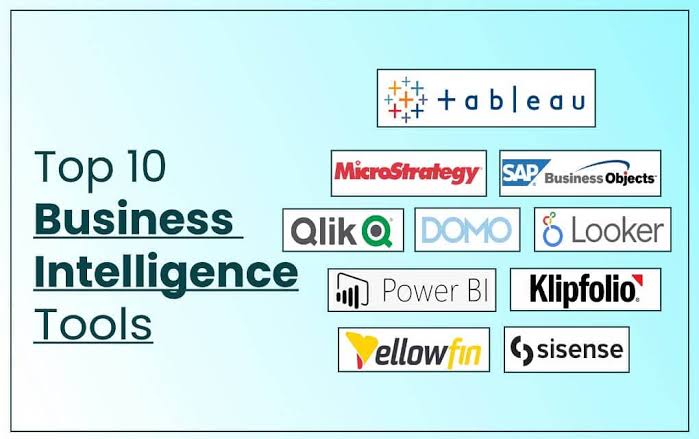The top 10 BI tools for 2025 highlight the importance of combining ease of use, scalability, and advanced analytics. Businesses that leverage these visualization platforms can better understand their data, respond to market changes faster, and ultimately gain a stronger competitive edge.
Top 10 Business Intelligence Tools for Data Visualization from 10 to 1
In today’s digital economy, businesses rely heavily on data-driven decisions to stay competitive. Data visualization has become a key component of this process because it allows organizations to interpret complex data in an easily understandable form. Business intelligence (BI) tools help transform raw data into interactive dashboards, charts, and reports that provide actionable insights. As of 2025, these tools have evolved with features like artificial intelligence integration, real-time analytics, and cloud-based collaboration. Below are the top 10 business intelligence tools for data visualization ranked from 10 to 1.
10. Zoho Analytics
Zoho Analytics is a cloud-based BI tool designed for small and medium businesses. It offers a simple interface that allows users to create dashboards and reports without advanced technical expertise.
Its strength lies in affordability and ease of use. Zoho Analytics integrates with popular applications like Google Workspace, Salesforce, and social media platforms, making it an excellent choice for businesses looking to track performance metrics across different operations.
9. SAS Visual Analytics
SAS Visual Analytics is known for its advanced analytics capabilities. It combines strong statistical analysis with powerful visualization options, making it highly suitable for organizations that handle large, complex datasets.
The tool also provides predictive analytics, helping businesses forecast trends and outcomes. Its AI-driven features support real-time decision-making, particularly in industries like healthcare, banking, and supply chain management.
8. Domo
Domo is a cloud-native BI platform that focuses on delivering insights in real time. Its strength lies in integrating data from multiple sources and presenting it in user-friendly dashboards.
Domo also offers strong collaboration features, allowing teams to share insights quickly across an organization. Its mobile compatibility ensures that decision-makers can access dashboards on the go, making it highly effective for fast-moving businesses.
7. Sisense
Sisense is designed to simplify data analysis through its unique in-chip technology, which speeds up data processing. It enables businesses to connect, analyze, and visualize large datasets efficiently.
One of its standout features is its ability to embed analytics directly into applications, giving businesses customized visual dashboards within their existing workflows. Sisense is popular with tech-driven companies that want to integrate analytics into customer-facing products.
6. MicroStrategy
MicroStrategy provides enterprise-grade BI with strong emphasis on scalability and security. It allows organizations to create detailed dashboards, mobile analytics, and real-time reporting.
Its integration with artificial intelligence and machine learning enables predictive analytics, helping businesses stay ahead of market shifts. MicroStrategy is widely used in finance, government, and large corporations where advanced security and compliance are essential.
5. Qlik Sense
Qlik Sense is widely recognized for its associative data model, which allows users to explore relationships within datasets without predefined queries. This makes data discovery intuitive and powerful.
It supports self-service analytics, enabling users to build visualizations and dashboards with minimal technical knowledge. Qlik Sense also integrates AI features to guide users toward insights they might have missed, making it a strong tool for businesses focused on exploration and innovation.
4. SAP BusinessObjects
SAP BusinessObjects is a veteran in the BI space, offering comprehensive reporting, visualization, and enterprise analytics tools. It is highly suited for large organizations with complex data environments.
Its strength lies in integration with SAP applications, making it a natural fit for businesses already using SAP’s ERP and CRM systems. SAP BusinessObjects offers robust dashboards and highly customizable reports for enterprise-level decision-making.
3. IBM Cognos Analytics
IBM Cognos Analytics combines AI-driven analysis with advanced visualization capabilities. It helps businesses uncover hidden patterns in data and offers recommendations based on machine learning.
Its natural language processing feature allows users to ask questions in plain language and receive data-driven answers in the form of charts and graphs. This user-friendly approach has made Cognos a popular choice for organizations seeking both simplicity and advanced intelligence.
2. Microsoft Power BI
Microsoft Power BI has rapidly become one of the most widely adopted BI tools in the world. Its seamless integration with Microsoft 365, Azure, and SQL databases makes it an obvious choice for businesses using Microsoft products.
Power BI offers interactive dashboards, real-time data monitoring, and strong collaboration tools. It is cost-effective, scalable, and supports a wide range of data sources. With AI integration and a strong ecosystem of connectors, Power BI is ideal for organizations of all sizes.
1. Tableau
At the top of the list is Tableau, a market leader in business intelligence and data visualization. Known for its powerful and intuitive interface, Tableau enables users to create interactive dashboards and share insights with ease.
Tableau supports large-scale data handling, integrates with various data sources, and offers advanced features such as predictive analytics, natural language queries, and AI-driven recommendations. Its strength lies in making complex data accessible through compelling visualizations.
Conclusion
Business intelligence tools are now indispensable for organizations looking to make informed decisions in a fast-paced environment. From Zoho Analytics for smaller businesses to Tableau and Power BI for enterprises, these tools empower organizations with the ability to turn raw data into meaningful insights.
